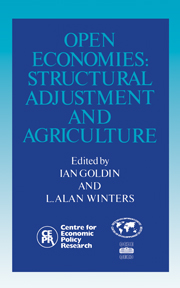Book contents
- Frontmatter
- Contents
- List of figures
- List of tables
- Preface
- Acknowledgements
- List of conference participants
- 1 Introduction: from macro to maize
- Part One Open economy analysis
- Part Two The small country assumption and trade reform
- Part Three Risk and adjustment
- Part Four Government's role
- 11 Infrastructure, relative prices and agricultural adjustment
- Discussion
- 12 Structural factors and tax revenue in developing countries: a decade of evidence
- Discussion
- 13 International dimensions of the political economy of distortionary price and trade policies
- Discussion
- Index
Discussion
from Part Four - Government's role
Published online by Cambridge University Press: 04 August 2010
- Frontmatter
- Contents
- List of figures
- List of tables
- Preface
- Acknowledgements
- List of conference participants
- 1 Introduction: from macro to maize
- Part One Open economy analysis
- Part Two The small country assumption and trade reform
- Part Three Risk and adjustment
- Part Four Government's role
- 11 Infrastructure, relative prices and agricultural adjustment
- Discussion
- 12 Structural factors and tax revenue in developing countries: a decade of evidence
- Discussion
- 13 International dimensions of the political economy of distortionary price and trade policies
- Discussion
- Index
Summary
It is always instructive and a pleasure to discuss a paper by Vito Tanzi. He and his Fiscal Affairs Department at the IMF possess a unique body of experience and wisdom in the analysis of taxation in developing countries. My comments will be organised as follows: (1) the general approach; (2) the data; (3) the econometrics; (4) the problems of agricultural taxation; (5) structural adjustment and agricultural taxation; (6) concluding remarks.
The general approach
The analysis of data from a cross-section of countries at a given point in time is one way of structuring comparative work, and one which can provide helpful lessons. There are, however, always problems in method and in interpretation. When we fit a relationship to a cross-section of countries explaining, for example, tax structure or tax levels in terms of variables such as income per capita or the share of agriculture in income, we have to ask what our fitted regression line or surface represents. Should we think of it as a description of structure or what people can do; or as a theory of policy, where we think of the successful as revealed by the regression line as showing what the unsuccessful should do; or do we regard it as a model of behaviour of the body politic of different countries? We find that we are in practice tempted to use all three of these interpretations.
A second question arises from seeing the relationship as a deterministic socioeconomic model. If we follow this approach literally we are essentially saying that the figures for each country arise from a statistical drawing from an underlying process which is common to all the countries.
- Type
- Chapter
- Information
- Open EconomiesStructural Adjustment and Agriculture, pp. 286 - 289Publisher: Cambridge University PressPrint publication year: 1992



